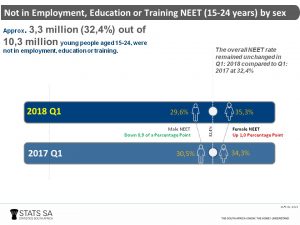Youth unemployment still high in Q1: 2018
The South African working-age population increased by 153 000 or 0,4 per cent in the first quarter of 2018 compared to the fourth quarter of 2017. The rise in both employment (up by 206 000) and unemployment (up by 100 000) over the quarter led to the rise in the labour force participation rate now standing at 59,3%. The unemployment rate (26,7%) remained unchanged over the first quarter of 2018 compared to the fourth quarter of 2017.
The South African youth are still vulnerable in the labour market. Youth unemployment, however, is not unique to South Africa; it is a global phenomenon. According to the International Labour Organization (ILO), there are about 71 million unemployed youth, aged 15–24 years, globally in 2017, with many of them facing long-term unemployment. In South Africa those aged 15–34 years are considered as youth.
South Africa’s unemployment rate is high for both youth and adults; however, the unemployment rate among young people aged 15–34 was 38,2%, implying that more than one in every three young people in the labour force did not have a job in the first quarter of 2018.
Some of these young people have become discouraged with the labour market and they are also not building on their skills base through education and training – they are not in employment, education or training (NEET).
The NEET rate serves as an important additional labour market indicator for young people. Of the 10,3 million persons aged 15–24 years, 32,4% (approximately 3,3 million) were not in employment, education or training – implying that close to one in three young South Africans between the ages of 15 and 24 years were disengaged with the labour market in the first quarter of 2018. The NEET rate declined among the black African and coloured males, while the rate increased among Indian/Asian and white males. Among females, the NEET rate increased for three population groups with the exception of coloured females.
The NEET rate, seen in conjunction with unemployment rates over 50%, suggests that South African young people face extreme difficulties engaging with the labour market. Certain factors such as lack of experience and length of unemployment may increase the vulnerabilities of these young people in the labour market.
The burden of unemployment is also concentrated amongst the youth as they account for 63,5% of the total number of unemployed persons. The unemployment rate among the youth is higher irrespective of education level. The graduate unemployment rate was 33,5% for those aged 15–24 and 10,2% among those aged 25–34 years, while the rate among adults (aged 35–64 years) was 4,7%. Just over 30% of the youth have jobs and about half of them participate in the labour market. Within the youth, those aged 15–24 years are more vulnerable in the labour market with an unemployment rate of over 52%, an absorption rate of about 12,2% and a labour force participation rate of 25,6%.
When young people are employed in the South African labour market, their employment intensity is the highest amongst the Trade, Agriculture, and Finance and other business services industries. Low and semi-skilled youth employment is concentrated in the Trade industry, while high-skilled youth employment is in the Community and social services as well as Finance and other business services industries.



